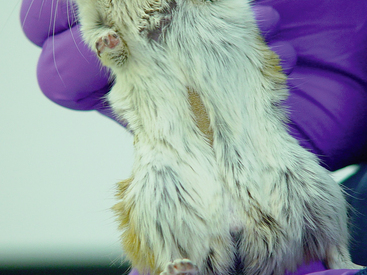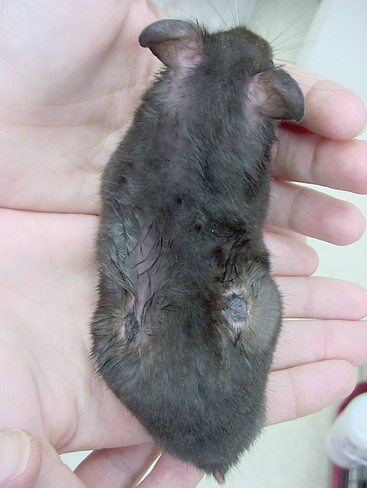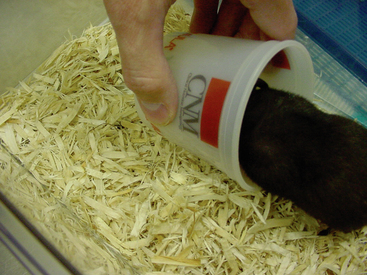CHAPTER 6 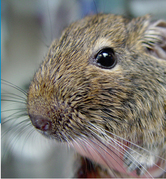 SMALL RODENT BEHAVIOR: MICE, RATS, GERBILS, AND HAMSTERS
SMALL RODENT BEHAVIOR: MICE, RATS, GERBILS, AND HAMSTERS
Introduction
Animals in the order Rodentia are generally thought of as small, nocturnal, ground-dwelling animals that chew or gnaw constantly. Actually rodents vary greatly in size and habitat preference, but they all have continuously growing incisors and tend to be nocturnally active.2,3,13,16 The constant need to chew can be endearing, as it makes them very busy and entertaining animals. It may also be somewhat unfortunate in pets, as it drives them to chew on their living quarters, often destroying their primary enclosure. This nocturnal behavior may also be annoying if these pets live in the bedrooms of their owners. But if we remain cognizant of normal rodent behaviors and provide appropriate caging, small rodents make great pets. Although many rodent species are kept as pets, only mice, rats, gerbils, and hamsters are discussed in this chapter.
Gerbils (Meriones unguiculatus) are native to Mongolia, China, and Manchuria and were first brought to the United States as research animals. In their native home, they live in a wide variety of desert habitats. The golden, or Syrian, hamster is native to southeast Europe and northwest Syria and was domesticated and brought to the United States as a research animal. Chinese hamsters are a separate species (Cricatus griseus) (with a lower chromosome number) and are native to eastern China. There are other species of hamsters, but these are the two most commonly seen as pets and in research.
Sensory Behaviors
Because these rodents are nocturnal and live on or in the ground, vision is their least-developed special sense, and rats, at least, are known to be colorblind.13 The rodent’s hearing is fairly well developed, and they appear to be able to sense ground vibrations.
Gerbils have a large ventral midline sebaceous gland that they often vigorously rub on substrates or surfaces in their cages (Figure 6-1). They slide on the belly or rub the abdomen on a vertical surface in an effort to mark territory. Male gerbils housed in social groups, with or without females, exhibit this behavior, with the most activity being evident in more dominant males housed with reproductively active females.10 This gland may actually enlarge and be mistaken by an owner or unknowing clinician for a tumor or abscess. Occasionally these glands may “plug,” forming a cystlike structure that is easily opened either when the gerbil is grooming or by rubbing it with a warm, moist gauze sponge.2,13,16 In lactating female gerbils, studies have shown that removal of this ventral scent gland caused retarded development of the nursing pups, indicating that the gland may have some form of brood patch function.6
Hamsters have bilateral scent glands on their flanks that are more developed in males (Figure 6-2).2,3,13,16 When hamsters mark their territory, they often throw themselves on their sides, then quickly rub the flank area on the substrate. They also will stand next to a surface and rub the flank, appearing to be “wiggling” the hips. These glands are commonly mistaken for tumors or abscesses, especially in actively breeding animals, when they are usually surrounded by wet fur.
Communicative Behaviors
Mice and rats produce similar vocalizations and often make clucking-type noises in the back of their throats, with or without other audible sounds, and occasionally while also grinding their teeth. If the animals are hungry or actively seeking food, these sounds may continue intermittently until they start eating. Female mice and rats are often heard making similar soft clucking noises while caring for their pups or grooming quietly in the cage. If mice and rats become agitated or frightened, their vocalizations become louder and sound more like squeaks or squeals. Generally, if a mouse or rat in pain is left alone, it remains very quiet. If it is handled or lifted by the base of the tail, however, the vocalizations can become quite loud, and the animal will also struggle to get away and may bite.3
Hamsters often “chortle” in their throats while they are alone in their cages, are interacting in a group, or are handled by a human. If they are not accustomed to being handled or are roughly handled by a stranger, they can “gritch” quite loudly, often simultaneously baring their teeth. If a hamster is disturbed while sleeping, it usually immediately rolls to its back, bares its teeth, and gritches quite loudly for several seconds, often continuing for many more seconds after being left alone.13 When the “threat” is over or they have been released into the cage, hamsters often continue vocalizing, gradually decreasing in volume to quiet “chortling” noises in the throat, while they pace around, settling back into a resting position. During this post-stress period, they can still be very easily and quickly aroused to a full “attack mode” with very little additional stimulation.
Although gerbils are not generally very vocal, they occasionally “chortle” quietly in their throats. But in the face of a potential threat, gerbils are more likely to stand on their hind legs and thump quickly with their hind feet than to vocalize.2,13 This thumping may occur more frequently when gerbils are housed in cages with floors that accentuate the noise or cause significant vibrations. If in pain, gerbils do occasionally squeak or squeal when restrained and may attempt to bite if they cannot get away.
Social and Antisocial Behaviors
In general, rodents are highly social animals. However, when rodents are confined in cages, there are limits to the number of individuals that can coexist peacefully. It is important that each animal have an adequate amount of space and the opportunity to perform species-typical behaviors.7 For rodents, two important and normal behaviors are chewing and hiding or burrowing. Therefore appropriate and adequate hard substrates for chewing and various types of nest boxes or bedding material should be provided to ensure normal social behaviors in caged rodents.3,7
Most mice can coexist quite peacefully, even in rather cramped quarters, with only a few exceptions. Males of some strains of mice (such as BALB/c) are quite aggressive, inflicting rather serious fight wounds on the tail or near the base of the tail, when confined together.3,13 In the laboratory, male mice have been reported to exhibit physiologic and behavioral stress along with increased aggression when housed in continuous light.17 Pet mice are generally not particularly aggressive toward one another, and males can often live in groups of two or maybe three in a large aquarium or cage. However, if someone wants to keep a group of mice as pets, it is recommended to purchase only females or to raise the males together from puberty, which can occur as early as 50 to 60 days of age (depending on the strain of mouse). Because mice are usually prolific breeders, it is recommended to keep single-gender groups to reduce antisocial behaviors such as fighting or cannibalism of pups.3,13
Mice and rats in compatible groups usually nest together and often pile on top of one another, usually in a corner of their enclosure (Figure 6-3). If there are any outcasts in the cage, they usually sleep separately from the group and may sleep in a more alert posture to allow them to easily monitor activity in the rest of the cage. In groups of adult mice and rats, hierarchies are often created, with the dominant animal easily identified. Especially in mice, the dominant animal can often be seen chewing the hair off other animals in the cage, a practice known as barbering.13,16 If areas of alopecia are devoid of parasites or signs of other medical causes such as seborrhea and excoriations barbering should be considered as a probable cause.3
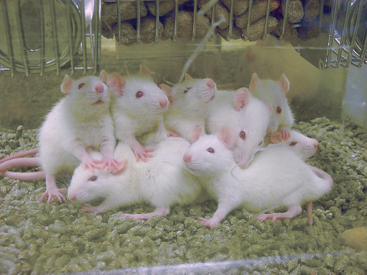
Figure 6-3 These juvenile rats are exhibiting normal “piled-on” social and sleeping behavior.
(Courtesy Teresa Bradley Bays.)
Although mice usually tolerate being handled, they are more prone to biting their owners than are rats. In fact, if mice are not accustomed to handling or believe they cannot escape, they are very likely to bite (Figure 6-4). If they do not break the skin when they bite, they usually pinch very hard and often hang on without letting go.
Of all the typical rodent species, rats and gerbils are the least likely to bite their owners, unless they are in pain. They are very tolerant of handling and even appear to show signs of affection for their owners. In my experience both rats and gerbils have responded to their spoken name and to the arrival of their owners.
Gerbils are a highly social and interactive species. They live well in pairs or small groups, especially if introduced to one another before puberty, and generally show signs of aggression only if in extremely overcrowded conditions. Barbering may also occur in gerbils, most often around the face and base of the tail. Unlike other rodents, gerbils are not truly nocturnal, as they are easily awakened and can remain quite active during the day. This, in combination with the lack of biting tendencies, makes gerbils ideal interactive pets, although they may be active during the night.13
Hamsters are often described as vicious animals, but if attention is paid to normal hamster behavior it can be better understood how we contribute to or cause that image. In general, hamsters lead more structured lives than the other common rodent pets and can therefore become more easily stressed in overcrowded conditions or when confined in a cage that is too small. Even when hamsters are living in a group, it is not uncommon for them to act as if they are living alone. They usually designate specific areas of their environment for separate activities (e.g., sleeping, eating, elimination) and use their extensive cheek pouches to move materials around the cage on a regular basis.3,13 Chinese, or dwarf, hamsters do not appear to be as easily stressed but do exhibit behaviors similar to those of the golden, or Syrian, hamster. All hamsters prefer having one or more hiding places per individual in a single cage.
Female hamsters can be extremely aggressive when caring for pups, and this aggression can be directed at other hamsters in the cage or at the owner.16 Newborn hamsters should not be disturbed for at least 3 to 4 days after birth to reduce the chance of cannibalism that may occur when a potential threat is perceived by the mother. Whenever possible, pregnant females should be housed in separate cages without males, to decrease the likelihood of maternal cannibalism. Even with all of these precautions, however, cannibalism by mother hamsters is still a strong possibility if they are stressed.13
Reproductive Behaviors
Male Reproductive Behaviors
Breeding behavior in all of these rodent species occurs mostly at night. Male rodents are increasingly territorial when housed with or able to smell females in estrus. Since estrous cycles occur more than once a week, it is best to house only one male in a cage with three to five female mice or rats. During this time, male mice may be a little more stressed and, therefore, may be more likely to bite their owners, even when housed only with females. Male rats may appear more anxious or active when housed with multiple breeding females but generally are not more inclined to bite.
Male rodents have open inguinal canals and can pull their testes into their abdominal cavity, especially when stressed or frightened. Therefore, the presence or absence of a scrotum should not be used to determine gender of a rodent. Instead, the anogenital distance is used to sex these species. Males have the longest distance between the anus and the genital opening, and their external genitalia has a circular opening rather than a slit.*
Stay updated, free articles. Join our Telegram channel

Full access? Get Clinical Tree


